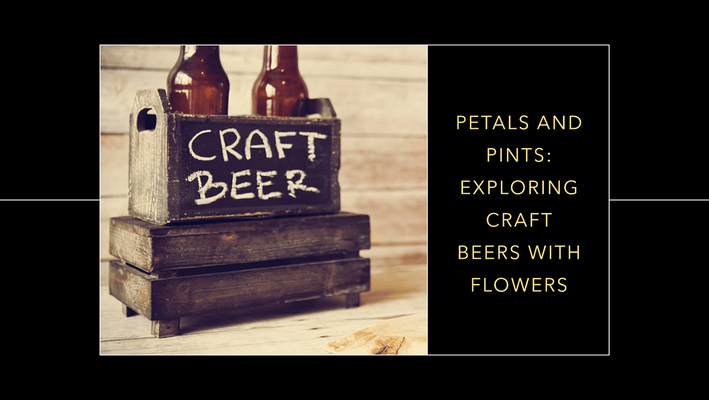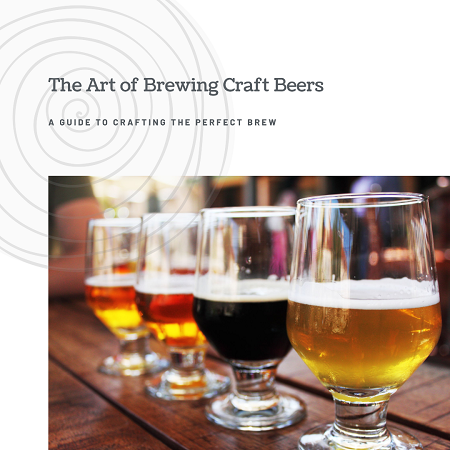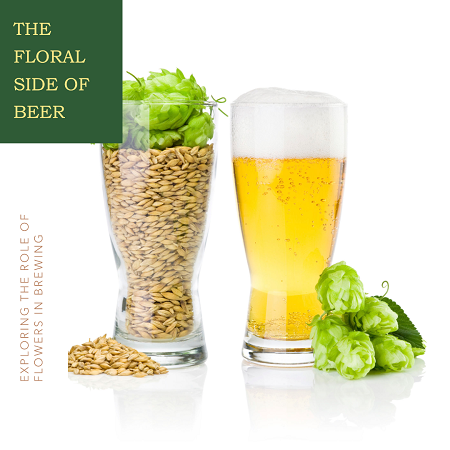Sip and Savour: Exploring the Unique Flavours of Flower-Infused Craft Beers

Key Points
- The brewing of craft beers is an art, and flowers have become an intriguing ingredient in this process.
- The use of flowers in beer brewing is not a new trend. Ancient brews often included floral elements, and modern brewers are exploring these ingredients with renewed interest.
- The brewing process involves careful balance and technique. Introducing flowers into this process adds another layer of complexity.
- There are various techniques for infusing floral flavours into beer, and the choice of flowers used can greatly influence the final product.
- Flowers like roses, hibiscus, elderflowers, chamomile, and lavender are commonly used, each contributing unique flavours and aromas. There are also less commonly known flowers being used in brewing.
- The science behind floral beers involves understanding the chemistry of floral flavours and how these contribute to the overall beer experience.
- Floral craft beers have a notable impact on the beer market, influencing consumer choices and trends.
- The future of floral craft beers looks promising, with predictions of continued exploration and commercial growth.
- The exploration of floral craft beers is a fascinating journey, showcasing the innovative, artisanal nature of the craft beer industry.
Welcome, beer enthusiasts and floral fanatics alike! In this intriguing blend of botany and brew, we journey through an unexpected trend sweeping the world of craft beer. With the ever-evolving creativity in the beer industry, it's no wonder brewers are continually exploring innovative flavours to keep beer lovers guessing – and the latest trend is brewing with flowers. If you're as intrigued as we are by this harmonious marriage of floral notes with the rich, robust world of craft beers, then you're in the right place!
Understanding the Art of Brewing Craft Beers

From selecting the best grains, hops, and yeast, to nailing the precise brewing process – temperature, timings, and all – there's a world of craft and precision that goes into each pint of craft beer. Each brewery has its secret methods, innovative techniques, and passion, which is then bottled as unique, flavourful craft beers.
The Growing Trend: Flowers in Craft Beer Brewing

As the craft beer industry grows, it continues to push boundaries, relentlessly seeking out the new and unusual to tantalise the taste buds of its diverse audience. A trend that's been picking up pace is the use of flowers in brewing. That's right - from elderflowers and hibiscus to lavender and even dandelions, a whole bouquet of flowers is making its way into the craft beer brewing process.
For centuries, flowers have been used to make beverages like teas, wines, and meads. They bring not only vibrant colours but a range of subtle to potent flavours that can transform the drink's taste profile. So, it was only a matter of time before innovative brewers began experimenting with flowers in their brews.
The Purpose of This Exploration
In this article, we will embark on a sensory journey through this blooming landscape, exploring different craft beers brewed with flowers, understanding what each flower brings to the beer, and why this trend is capturing the hearts of craft beer aficionados worldwide.
The History of Brewing Beers with Flowers
Dipping into the annals of history, we find that the incorporation of flowers in brewing is by no means a novel concept. In fact, it's a practice rooted in the very origins of brewing itself.
A Flashback to Ancient Brews
Long before hops became the norm in beer brewing around the 9th century, a diverse array of ingredients was used to balance the sweetness of the malt and to add flavour and preservation qualities to the beer. This concoction was often referred to as "gruit" and typically included various herbs, spices, and indeed, flowers.
In particular, the use of flowers and plants such as heather, bog myrtle, and yarrow was prevalent in the brews of Celtic and Nordic societies. These flowers not only provided the necessary bitterness but also lent distinctive aromas and flavours to the beer, making each brew a unique experience.
Charting the Evolution: From Past to Present

While hops have dominated the brewing landscape for the past few centuries due to their excellent preserving properties and the crisp bitterness they offer, the rise of craft brewing has witnessed a resurgence in the use of flowers. Today's craft brewers are constantly seeking out novel ingredients to set their beers apart in an increasingly competitive market, leading to a renaissance of sorts for floral brews.
However, the use of flowers in today's craft beers differs quite significantly from the gruits of old. Instead of using flowers as a necessary component for bitterness, modern brewers use them to add unique flavour profiles and enticing aromas to their beers, enhancing the sensory experience of each sip. This modern use of blooms is more about augmenting the beer's character, making each floral brew a work of art in its own right.
A Closer Look at the Brewing Process
Before we can fully appreciate the role of flowers in the brewing process, it's essential to first understand the traditional brewing process. Beer brewing is an art form, one that balances exact science with creative flair.
Traditional Beer Brewing Process Explained
The traditional brewing process involves four main ingredients: water, malted barley, hops, and yeast. t all kicks off with a step known as malting. Imagine, if you will, barley grains having a bit of a soak in water, then being given the chance to sprout a tad. After this, they're whisked off and dried in a kiln. Now you might be wondering, why all this fuss? Well, this merry dance is how we get the enzymes we need to transform the starches in the grain into sugars that can be fermented. There you go, brewing magic at its finest!
The malted barley is then steeped in hot water through a process called mashing. The heat activates the enzymes in the barley, converting the remaining starches into sugars. This creates a sweet liquid known as 'wort'.
The wort is then boiled, and hops are added for bitterness, flavour and aroma. After boiling, the wort is cooled and yeast is added, initiating the fermentation process. The yeast consumes the sugars in the wort, producing alcohol, carbon dioxide, and additional flavours. Once fermentation is complete, the beer is conditioned, filtered, and carbonated before being packaged for sale.
The Role of Flowers in Brewing
When it comes to brewing with flowers, the process diverges from the traditional method at the stage of boiling the wort. Instead of relying solely on hops, brewers add selected flowers to infuse their unique flavours and aromas into the beer.

The timing of adding these flowers is crucial to the final flavour profile. If added early in the boil, the flowers contribute to the beer's bitterness while their aromatic qualities are largely lost. On the other hand, adding flowers later in the boil or during fermentation (a process known as 'dry-flowering', akin to dry-hopping) allows the beer to absorb the unique aromatics and delicate flavours of the flowers, without significantly increasing the beer's bitterness.
Thus, the use of flowers gives brewers another palette to play with, enabling them to create uniquely flavoured beers that stand out from the crowd.
Brewmasters’ Techniques
Brewing beer with flowers is a complex endeavour, requiring a deft hand and an intimate understanding of how different botanicals interact with the fundamental ingredients of beer. This section offers an inside look into the intriguing methods employed by brewmasters to achieve their unique floral brews.
Techniques and Processes Used for Infusing Floral Flavours

Just as the choice of flowers is vital, so too is the technique used to infuse their flavours into the brew. Many brewers favour the 'dry-flowering' method, which, much like dry-hopping, involves adding flowers during or after fermentation. This technique allows for the maximum extraction of floral aromas and flavours, without adding undue bitterness.
However, others may choose to add flowers during the boil, particularly if they are aiming for a more subtle infusion or wish to incorporate some of the flower's inherent bitterness into their brew.
Some adventurous brewers experiment further, creating flower tinctures or syrups to be added into the beer at different stages, thereby layering the floral notes in more complex ways.
In all these techniques, the brewmaster's skill and creativity are paramount. Each decision, from the choice of flower to the method of infusion, contributes to the uniqueness of the final brew – a testament to the artistry involved in brewing craft beers with flowers.
Types of Flowers Used in Craft Beer Brewing
Just as an artist uses a palette of different colours to create a masterpiece, brewmasters have a variety of flowers at their disposal to craft their unique brews. This section explores some of the more commonly used floral ingredients, as well as a few lesser-known botanicals that are making waves in the craft beer scene.
Roses: A Classic Floral Ingredient
Roses, known universally for their intoxicating aroma, are also a classic ingredient in beer brewing. Whether it's the petals or the hips, roses lend a delicate floral note and a hint of tartness to the beer, creating a wonderfully balanced brew.
Hibiscus: Tropical Touch to the Brew
Hibiscus flowers, with their vibrant colour and cranberry-like tartness, are a popular choice for craft brewers looking to impart a tropical touch to their beer. Often used in wheat beers or sour ales, hibiscus flowers give the brew a captivating ruby red colour and a refreshing tartness.
Elderflowers: Creating a Subtle, Sweet Flavour
The sweet, slightly musky scent of elderflowers makes them a delightful addition to lighter beer styles. Brewmasters often use elderflowers to create subtly sweet and highly fragrant brews that are as pleasing to the nose as they are to the palate.
Chamomile: The Soothing Ingredient
Known for its calming properties, chamomile imparts a soothing, apple-like sweetness to beers. Typically used in Belgian wits or blond ales, chamomile contributes a soft complexity that can round out a brew beautifully.
Lavender: A Dash of Fragrance and Flavour
Lavender is another floral ingredient that's gaining popularity in the craft beer world. Its distinct aromatic profile – at once floral, sweet, and slightly herbaceous – makes it a compelling choice for experimental brewers. Used sparingly, lavender can add a fascinating layer of fragrance and flavour to the beer.
Unique Floral Choices
While the above-mentioned flowers are relatively common in the craft beer scene, many breweries are venturing into the world of lesser-known botanicals. Flowers like marigolds, dandelions, and even yarrow are finding their way into brews, as brewers experiment with different flavour profiles and explore the vast possibilities of floral brewing. Each unique choice expands the boundaries of traditional brewing, propelling the industry into exciting new territories.
The Science Behind Floral Beers
Crafting a beer that effectively and deliciously showcases the delicate nuances of flowers is both an art and a science. A deep understanding of the chemistry behind floral flavours is crucial in achieving this, which is what makes the exploration of floral beers so fascinating.
Understanding the Chemistry of Floral Flavours

Flowers, like all plants, contain a variety of organic compounds that contribute to their unique aromas and flavours. These compounds include essential oils, terpenes, and phenols, each contributing different aspects to the taste profile. Brewmasters must skillfully manage the brewing process to ensure these delicate compounds are not destroyed by the heat, preserving the flower's essence in the final product.
Moreover, the interaction between the floral components and the beer's base ingredients is also important. The sugars from the malt, the bitterness from the hops, and the floral notes must harmoniously meld together, creating a balance that does not overshadow any single element.
How Floral Beers Impact the Beer Market
The introduction of floral beers to the market has undoubtedly created a buzz. Craft beer enthusiasts are always on the hunt for unique, flavourful experiences, and floral beers have certainly delivered in this regard.
The use of flowers not only enhances the sensory experience but also taps into the consumer's desire for natural, botanical ingredients. This has resulted in an increased demand for floral beers, encouraging more breweries to experiment with flowers in their brewing process.
Furthermore, floral beers have opened up the market to consumers who may not typically enjoy traditional beers. The novel and often more subtle flavours appeal to a broader audience, including wine and cocktail lovers, contributing to a steady growth in the beer market.
Lastly, it has also fostered a greater sense of creativity and innovation within the industry, as breweries strive to create unique, flavourful brews that stand out in an increasingly crowded market.
The Future of Floral Craft Beers
The future appears rosy for floral beers, with craft beer aficionados and breweries alike savouring the refreshing and innovative flavours these brews bring to the table. From brewmasters' predictions about the next big thing in floral beers to the commercial scope discussed by industry experts, let's dive into what the future might hold for this blooming sector.
Brewmasters' Predictions: The Next Big Thing in Floral Beers
Conversations with several prominent brewmasters suggest that experimentation with new flowers and brewing techniques will continue to be the trend. The potential use of flowers that are currently less common, such as marigolds, calendula, and even dandelions, hints at an exciting and vibrant future for the industry.
Moreover, many predict an increase in the number of seasonal floral beers, matching flowers to their blooming season for fresh and distinct flavours. As consumers become more conscious about sustainability, using locally sourced, seasonal flowers can add another layer of appeal to these craft beers.
The Commercial Scope: Industry Experts' Opinions

Industry experts foresee floral beers as a growth area in the craft beer market. The consumer trend towards artisanal and local products coupled with the ongoing demand for novel, flavourful experiences paints a promising picture for the future of floral beers.
Additionally, as the craft beer market expands globally, the incorporation of regional flowers into local brews can offer an exciting way to represent local flavours and cultures. This opens up new avenues for breweries to explore and makes way for truly diverse and global expressions of floral beers.
While the market for floral beers is currently niche, the steady growth and increasing interest from consumers suggest that floral brews may soon become a more mainstream offering in the craft beer industry.
Summing Up...
As we wrap up our 'Petals and Pints' journey, it's evident that the craft beer industry is one thriving on creativity, innovation and an enduring commitment to quality. We've voyaged through the rich history of beers brewed with flowers, dissected the brewing process, delved into brewmasters' unique techniques, and explored a variety of flowers that breathe life and flavour into the brews.
The realm of floral craft beers offers an intersection of tradition and innovation that not only enhances the flavour profiles of these artisanal beverages, but also pays homage to ancient brewing practices. The incorporation of flowers like roses, hibiscus, elderflowers, chamomile, and lavender has transformed the craft beer landscape, making each sip a bouquet of delightful experiences.
Unearthing the science behind floral beers helped us appreciate the complex chemistry that goes into crafting these special brews. With brewmasters and industry experts' predictions, we look forward to a future brimming with new flavours, techniques, and, of course, flowers.
To conclude, floral beers are a blossoming testament to the craft beer industry's dynamism, their journey reflecting the industry's growth from grass roots to a globally appreciated art form. With the ever-evolving consumer palate and the brewmasters' ingenuity, the stage is set for the floral craft beers' exciting future, one pint at a time.
